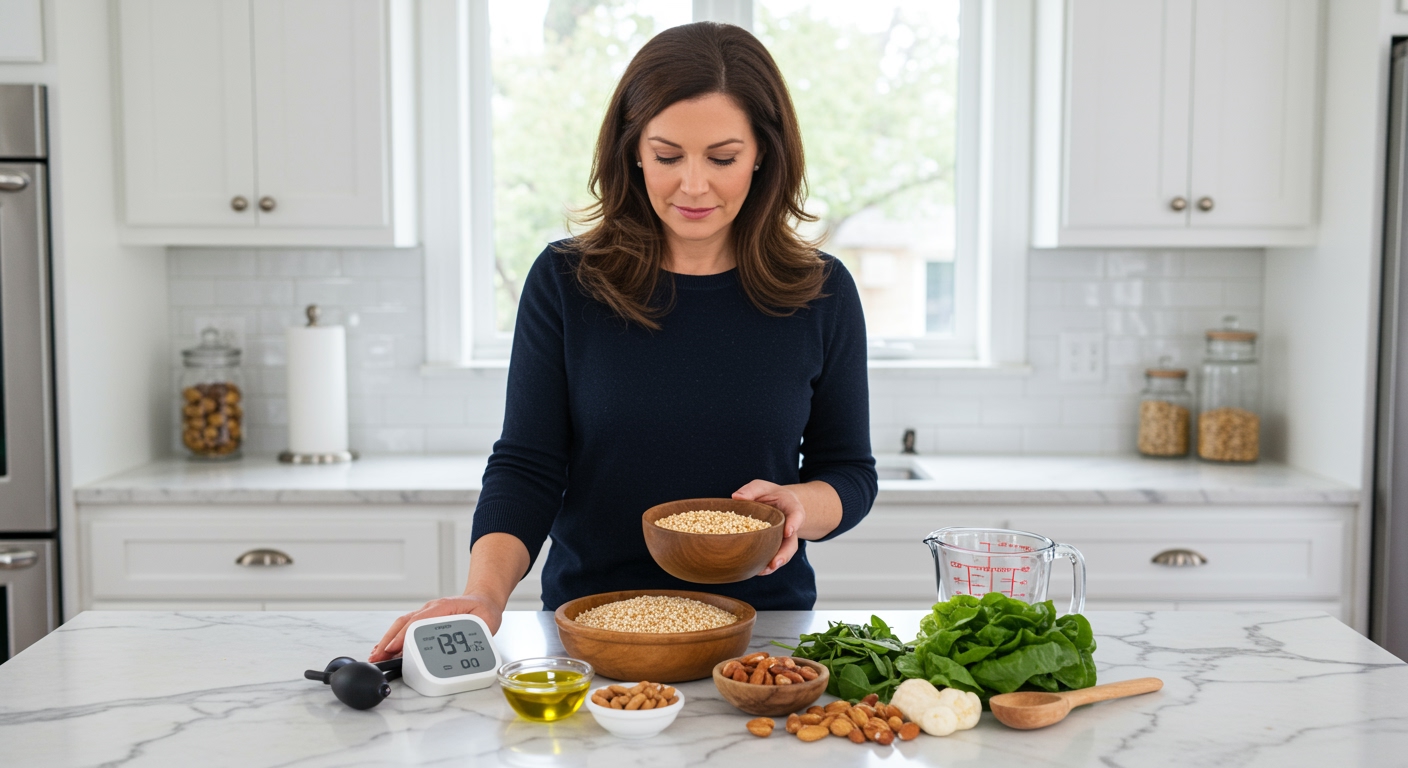✪ Key Takeaway: Freekeh supports blood pressure management through high fiber, potassium, and magnesium content that promotes healthy circulation.
Introduction
Your doctor just told you to watch your blood pressure, and now you are staring at endless lists of foods you should and should not eat.
You might be wondering if ancient grains like freekeh can actually help manage your blood pressure, especially when modern processed foods seem to make everything worse.
Hi, I am Abdur, your nutrition coach, and today I am going to explain how freekeh products can support your blood pressure management goals through their unique nutritional profile.
What Makes Freekeh Different From Regular Grains?
Freekeh stands apart from regular wheat because it gets harvested early when the grain is still green and soft.
This early harvesting process preserves more nutrients and creates a grain with higher protein content than mature wheat.
The roasting process that follows gives freekeh its distinctive nutty flavor while maintaining its nutritional density.
One cup of cooked freekeh contains about 8 grams of protein and 16 grams of fiber, which is significantly higher than most processed grains.
This fiber content plays a crucial role in cardiovascular health by helping your body process cholesterol more effectively.
The mineral profile of freekeh includes substantial amounts of potassium, magnesium, and iron that directly support healthy blood pressure levels.
✪ Fact: Freekeh contains four times more fiber than brown rice and twice the protein content of quinoa.
How Does Fiber Impact Blood Pressure Control?
The high fiber content in freekeh works through multiple mechanisms to support healthy blood pressure levels.
Soluble fiber binds to cholesterol in your digestive system and helps remove it from your body before it can clog your arteries.
This process reduces the workload on your heart and allows blood to flow more easily through your vessels.
Fiber also slows down the absorption of sugars, preventing the blood sugar spikes that can stress your cardiovascular system.
Research shows that people who consume 25-30 grams of fiber daily have lower blood pressure readings compared to those eating low-fiber diets.
The fiber in freekeh feeds beneficial gut bacteria that produce short-chain fatty acids, which have anti-inflammatory effects on blood vessels.
These anti-inflammatory compounds help keep your arteries flexible and responsive to changes in blood flow.
✪ Pro Tip: Start with half a cup of cooked freekeh daily and gradually increase to avoid digestive discomfort.
Why Are Potassium And Magnesium Important For Blood Pressure?
Freekeh provides significant amounts of potassium, a mineral that directly counteracts the blood pressure-raising effects of sodium.
Your kidneys use potassium to help remove excess sodium from your bloodstream, reducing the volume of fluid your heart needs to pump.
One cup of cooked freekeh contains about 410 milligrams of potassium, contributing meaningfully to the recommended daily intake of 3,500-4,700 milligrams.
The magnesium content in freekeh supports the relaxation of blood vessel walls, allowing them to expand and reduce pressure.
Magnesium acts as a natural calcium channel blocker, preventing excessive calcium from causing blood vessels to contract too tightly.
Studies indicate that people with higher magnesium intake have lower rates of hypertension and cardiovascular disease.
The combination of potassium and magnesium in freekeh creates a synergistic effect that supports optimal blood pressure regulation.
✪ Note: Cooking freekeh in low-sodium broth instead of water maximizes its blood pressure benefits.
What About The Glycemic Impact Of Freekeh?
Freekeh has a moderate glycemic index of around 43, which means it causes a slower, more controlled rise in blood sugar levels.
This steady blood sugar response prevents the insulin spikes that can contribute to inflammation and blood vessel damage over time.
The protein content in freekeh further slows digestion and helps maintain stable blood sugar levels throughout the day.
Stable blood sugar levels reduce stress on your cardiovascular system and help maintain consistent blood pressure readings.
People with diabetes or prediabetes often see improved blood pressure control when they choose low-glycemic grains like freekeh over refined alternatives.
The complex carbohydrates in freekeh provide sustained energy without the blood sugar rollercoaster that stresses your heart and blood vessels.
✪ Fact: Pairing freekeh with healthy fats like olive oil further slows carbohydrate absorption and enhances nutrient uptake.
How Should You Include Freekeh In Your Diet?
Start by replacing refined grains like white rice or pasta with cooked freekeh in your regular meals.
You can use freekeh in salads, soups, and grain bowls just like you would use quinoa or brown rice.
Cook freekeh in a 2:1 ratio of liquid to grain, simmering for about 20-25 minutes until the grains are tender but chewy.
Combine freekeh with vegetables, lean proteins, and healthy fats to create balanced meals that support blood pressure management.
The nutty flavor of freekeh pairs well with Mediterranean ingredients like olive oil, herbs, and fresh vegetables.
You can prepare large batches of cooked freekeh and store them in the refrigerator for up to five days for quick meal assembly.
Remember that freekeh contains gluten, so people with celiac disease or gluten sensitivity should choose alternative grains like quinoa or buckwheat.
✪ Pro Tip: Rinse freekeh before cooking to remove any debris and achieve the best texture and flavor.
The Bottom Line
Freekeh products can be valuable additions to a blood pressure management plan due to their high fiber, potassium, and magnesium content.
Real nutrition happens when you choose foods that work with your body, not against it.
I would love to hear about your experiences with freekeh or any questions you have about incorporating ancient grains into your heart-healthy eating plan in the comments below.
References
At NutritionCrown, we use quality and credible sources to ensure our content is accurate and trustworthy. Below are the sources referenced in creating this article:
- Healthline: Freekeh Benefits and Recipes
- Dr. Axe: Freekeh Nutrition Facts and Health Benefits
- Clean Eating Magazine: The Best New Foods for Better Heart Health
- Food to Live: Delicious and Nutritious Health Benefits of Freekeh





